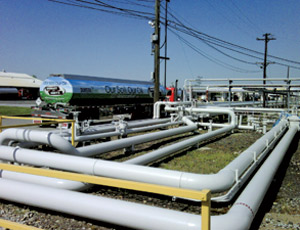The biofuels sector experienced a plant construction boom prior to the recession, but it stopped short of providing enough infrastructure needed to market the fuels. Now, downstream distribution is catching up to fulfill requirements of the federal Renewable Fuel Standard, which requires about 14 billion gallons of ethanol and 800 million gallons of biodiesel blended into U.S. fuels this year.

RFS forces the traditional oil industry to introduce biofuels into the retail market. Sinclair Oil, Marathon Oil, Magellan Midstream Partners and others have announced plans this year to upgrade terminals to increase biofuel capabilities. The construction industry is both a supplier and consumer: While producers look to construction firms to help with the upgrades, construction equipment increasingly runs on biofuels.
“Civil engineering services are needed for fuel containment and unloading capabilities, mechanical for blending apparatus installation and electrical for heating and insulation,” explains Matt Griswold, president of Blendstar, a fuel-logistics consulting firm and terminal operator in The Woodlands, Texas. In addition, concrete, piping, welding and tank-building are needed on the construction side.
Although producers can use different methods to comply with RFS, David Blatnik, senior business development adviser for Houston's Marathon, has his doubts, saying, “Can we do that right now just in terms of our biofuels blending capacity? No.” He says only four of the firm's 63 terminals can handle biodiesel. “We couldn't make any final decisions on new terminal construction until the [Environmental Protection Agency] issued its final ruling on RFS...in 2010,” Blatnik says.
The updated standard, called RFS-2, demands upgrades on existing terminals. Those terminals serve as a crucial link in the fuel supply chain, as tanker trucks rely on them to fill up for deliveries.
Because of compatibility issues with petrol-based products, terminals require special storage and equipment to handle biofuels. For example, biodiesel is a methyl ester that contains free fatty acids, and the fuel has a tendency to gel at cold temperatures. “We’ve looked at zone heating systems as well as different kinds of jacketing and paints for our storage tanks, ” says Bruce Heine, spokesman for Magellan Midstream Partners, Tulsa, Okla., which operates 85 terminals in 22 states. “Blenders, new fuel lines—all are needed to handle biodiesel,” says Heine.
Biofuels remain controversial. During an April 13 U.S. Senate hearing on RFS-2 and the Clean Air Act, Sen. James Inhofe (R-Okla.) argued that renewable-fuel mandates add pressure to the already strained U.S. economy, don't significantly reduce greenhouse-gas emissions and contribute to escalating food prices. Even so, the U.S. now has over 13 billion gallons of ethanol and 2.5 billion gallons of biodiesel plant capacity, say supporters.
Each terminal retrofit is expected to cost nearly $2 million, but no one knows for sure how many retrofit projects are needed. One reason for the uncertainty is that the EPA allows producers to buy renewable credits from others who exceed the standard.
“In the long run, I think [producers] are going to see that building and retrofitting terminals to handle biodiesel is going to have more economic benefit than buying [credits],” says Joe Gershen, sales and marketing manager for Crimson Renewable Energy, a 30-million-gallon-per-year biodiesel plant in Bakersfield, Calif.
Demand will determine the pace for new engineering and construction at the terminal level, add officials at Magellan. “Some of these systems can cost millions, so we work closely with our customers to meet their demands,” says Heine. “We generally look for a multiyear volume and rate commitment before we upgrade our terminal assets.”

Post a comment to this article
Report Abusive Comment